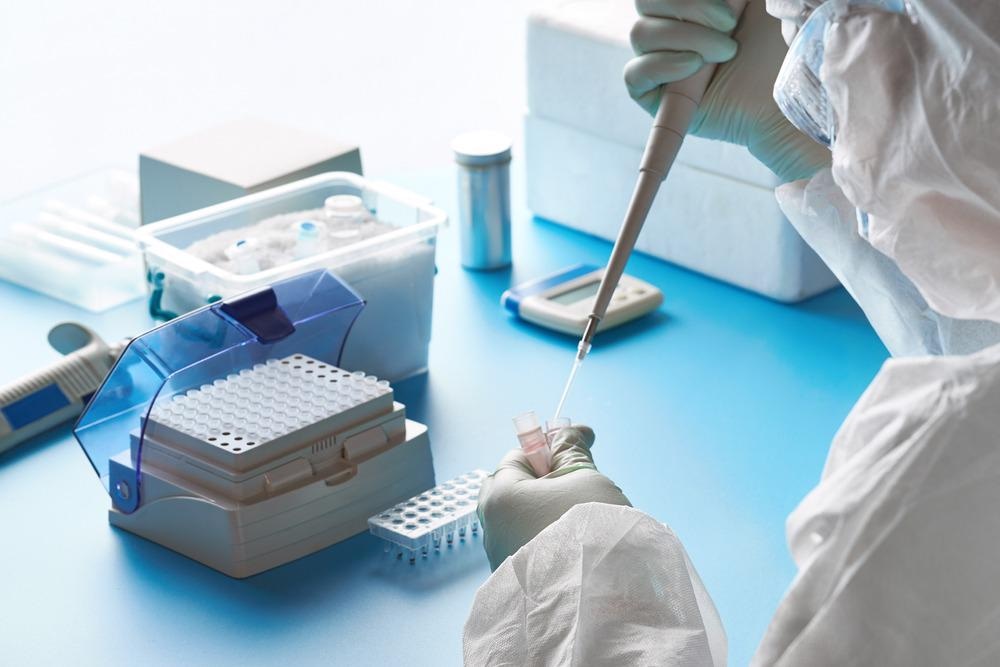The continual development of nanotechnology and its aim to advance various fields such as nanomedicine has encompassed utilizing magnetic nanoparticles for nucleic acid detection.

Image Credit: Motortion Films/Shutterstock.com
With nucleic acids being the primary material for the storage and transmission of genetic material, they can aid in detecting genetic changes associated with health conditions.
Why is Early Nucleic Acid Detection Necessary?
Nucleic acids hold significant value in biological functions as they are one of the most fundamental building blocks of human life. The exploitation of nucleic acids can allow for advancements in disease diagnoses that may have previously been obscured until a late stage – resulting in a poor prognosis.
Existing research has shown that breast cancer susceptibility gene mutations are the main cause of breast cancer family clustering. Additionally, studies have also illustrated that the FLT3 gene mutation is a key gene mutation in patients with acute myeloid leukemia (AML).
The use of gene sequencing has shown that lung cancer-related genes such as epidermal growth factor receptor gene mutation and others can play a significant role in diagnosing and treating lung cancer. This can also be related to other diseases and disorders which may benefit from early nucleic detection of gene mutations such as Type 1 and Type 2 diabetes mellitus, Lymphoma, bowel cancer, and prostatic cancer.
Utilizing early nucleic acid detection could be critical for advancing medicine through the identification of gene mutations to prevent and treat diseases, providing patients with the best level of care and remarkable prognoses.
Current Nucleic Acid Detection Method
The polymerase chain reaction (PCR) method is currently considered the gold standard for detecting nucleic acids. However, with clearer disadvantages that have come to light from consistent use, the development of novel nucleic acid detection methods is critical.
The PCR technique is notorious for its lengthy steps, and this translates to being time-consuming and not an efficient method for fast diagnosis. Additionally, the equipment and consumables necessary to perform a PCR test are expensive, with those performing the test requiring specific training.
Developing a novel innovative method of detecting nucleic acids fast and economically friendly is significant for advancing early disease diagnosis. This is especially necessary for medical institutions in developing countries that may depend on tests for disease control but cannot afford or maintain the expense that PCR tests require. Additionally, with the pandemic also depending on this test to detect the SARS-CoV-2 (COVID-19) virus, its drawbacks are becoming more apparent – the diagnosis and treatment of sudden infectious diseases cannot be dependent on such a lengthy process.
Magnetic Nanoparticles
Magnetic nanoparticles (MNPs) benefit from the dual characteristics of their eponymous derivatives, magnetic particles and nanoparticles (NPs). This incorporation of nanotechnology utilizes nanosized particles that pertain to a scale of 1 and 100 nm in size and produce a response when presented in a magnetic field. The advantage of this collaboration includes the large surface area to volume ratio, which enhances their efficacy.
These critical nanoparticles utilize magnetic beads, which can be a powerful tool for nucleic acid extraction. The coupling of magnetic properties with specific ligands in magnetic beads enables the separation and purification of nucleic acids effectively and efficiently.
This technique has been used to drive biomedical research with its application as a biosensor to capture and ultra-sensitively detect microRNA from the total RNA of cancer cells. MNPs have also been used to extract DNA and RNA from cancer cells simultaneously.
MNPs are used frequently in various fields, namely, materials science, electrochemistry, biochemical sensing, magnetic resonance imaging (MRI), environmental and medical research. Their versatile applications can be seen to be significant with roles in medicine as well as within other industries, such as removing pollutants and toxicity through membrane separation for the purification and treatment of water systems.

Image Credit: anyaivanova/Shutterstock.com
Utilizing MNPs to detect pathogens and target genomic regions of interest for variant discovery and infectious disease detection has made them a highly desirable tool for scientists to improve accuracy, sensitivity assays, and expense surrounding experiments.
Current research focusing on MNPs for sensitive detection of pathogens has attracted great attention due to the associated low cost and ease in operation and automation.
Research into efficient extraction of nucleic acids has led to the development of a rapid and effective universal nucleic acid extraction kit based on magnetic beads.
MNPs for Detecting Gene Mutations
Detecting gene mutations and tumor markers is significant for early cancer diagnosis during the screening period. The utilization of magnetic nanoparticles with specific ligands enables these markers to be detected and is one step closer to providing early diagnoses.
This novel approach to isolating nucleic acids is introduced through coupling molecules that bind specifically to nucleic acids and can be easily separated and isolated with magnetic field application.
Research encompassing this method has been used by various researchers investigating pathogens from Salmonella to avian influenza viruses. While this application of nano-magnetic material-based throughput sequencing method can enhance sensitivity, selectivity, and simultaneous detection of different sequences, the journey towards a translatory product may still require further research on optimization.
This nanotechnology application has great potential for disease diagnosis and therapeutics and could potentially aid in identifying and treating genetic mutations long before symptoms, revolutionizing modern medicine.
Continue reading: Clinical Applications of Chitosan Nanoparticles
References and Further Reading
Tang, C., He, Z., Liu, H., Xu, Y., Huang, H., Yang, G., Xiao, Z., Li, S., Liu, H., Deng, Y., Chen, Z., Chen, H. and He, N., (2020) Application of magnetic nanoparticles in nucleic acid detection. Journal of Nanobiotechnology, 18(1). Available at: https://doi.org/10.1186/s12951-020-00613-6
Tong, S., Zhu, H. and Bao, G., (2019) Magnetic iron oxide nanoparticles for disease detection and therapy. Materials Today, 31, pp.86-99. Available at: https://doi.org/10.1016/j.mattod.2019.06.003
Disclaimer: The views expressed here are those of the author expressed in their private capacity and do not necessarily represent the views of AZoM.com Limited T/A AZoNetwork the owner and operator of this website. This disclaimer forms part of the Terms and conditions of use of this website.